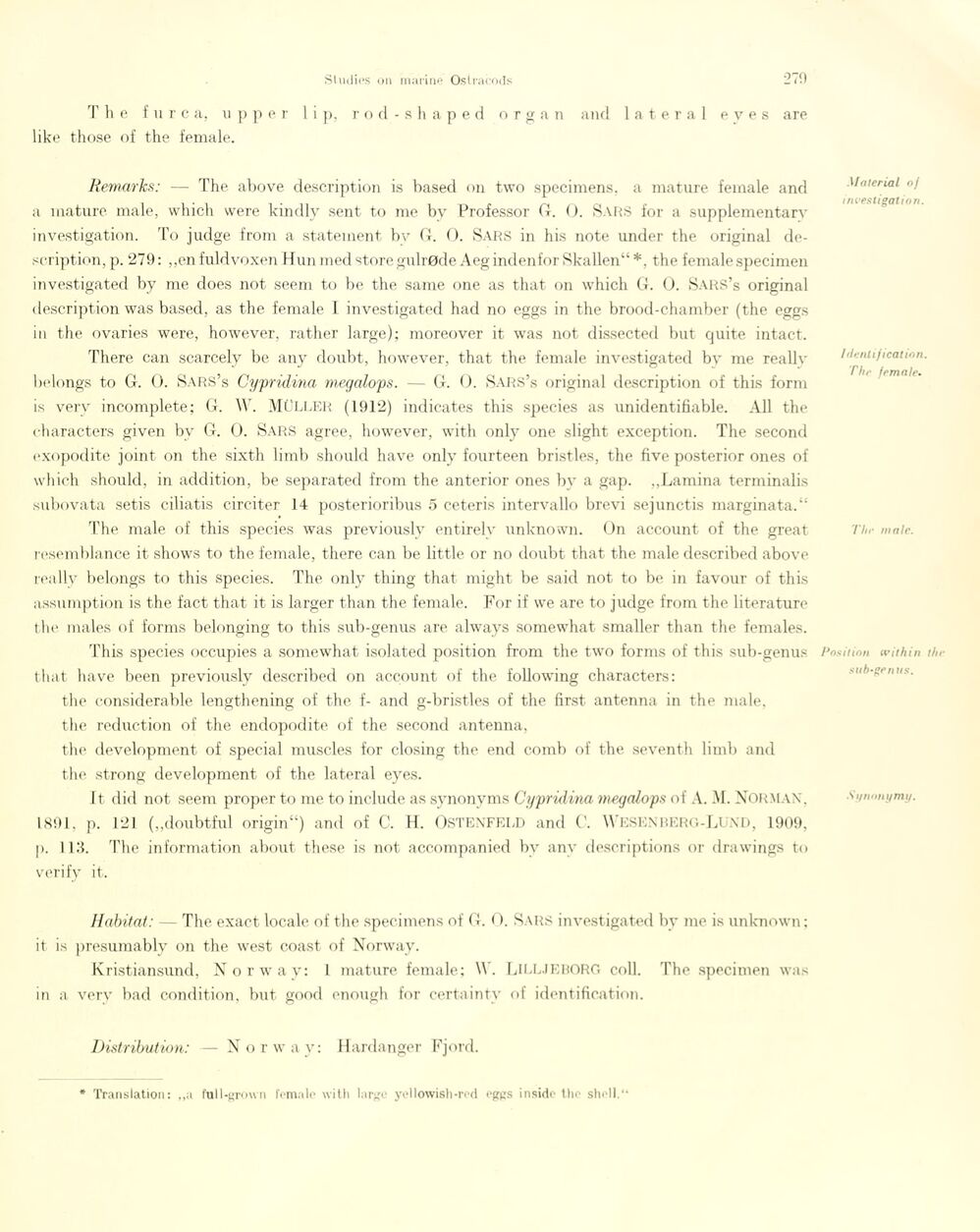
Full resolution (JPEG) - On this page / på denna sida - Sidor ...

<< prev. page << föreg. sida << >> nästa sida >> next page >>
Below is the raw OCR text
from the above scanned image.
Do you see an error? Proofread the page now!
Här nedan syns maskintolkade texten från faksimilbilden ovan.
Ser du något fel? Korrekturläs sidan nu!
This page has never been proofread. / Denna sida har aldrig korrekturlästs.
The furca, upper 1 i p, rod-shaped organ and lateral e y e s are
like those of the female.
Remarks: — The above description is based on two specimens, a mature female and
a mature male, which were kindly sent to me by Professor G. 0. Sars for a supplementarv
investigation. To judge from a statement by G. O. SARS in his note under the original
description, p. 279: „enfuldvoxen Hun med store gulrøde Aeg indenfor Skallen“*, the female specimen
investigated by me does not seem to be the same one as that on which G. 0. Sars’s original
description was based, as the female I investigated had no eggs in the brood-chamber (the eggs
in the ovaries were, however, rather large); moreover it was not dissected but quite intact.
There can scarcely be any doubt, however, that the female investigated by me reallv
belongs to G. 0. Sars’s Cypridina megalops. — G. 0. Sars’s original description of this form
is verv incomplete; G. W. MÜLLER (1912) indicates this species as unidentifiable. All the
characters given by G. 0. Sars agréé, however, with only one slight exception. The second
exopodite joint on the sixth limb should have only fourteen bristles, the five posterior ones of
which should, in addition, be separated from the anterior ones by a gap. „Lamina terminalis
subovata setis ciliatis circiter 14 posterioribus 5 ceteris intervallo brevi sejunctis marginata.“
The male of this species was previously entirely unknown. On account of the great
resemblance it shows to the female, there can be little or no doubt that the male described above
really belongs to this species. The only thing that might be said not to be in favour of this
assumption is the faet that it is larger than the female. For if we are to judge from the litera ture
the males of forms belonging to this sub-genus are always somewhat smaller than the females.
This species occupies a somewhat isolated position from the two forms of this sub-genus
that have been previously described on account of the following characters:
the considérable lengthening of the f- and g-bristles of the first antenna in the male,
the réduction of the endopodite of the second antenna,
the development of special muscles for closing the. end comb of the seventh limb and
the strong development of the lateral eyes.
It did not seem proper to me to include as synonyms Cypridina megalops of A. M. NORMAN,
1891, p. 121 („doubtful origin“) and of C. H. OSTENFELD and (’. WeSENBERG-LUND, 1909,
p. 113. The information about these is not accompanied by any descriptions or drawings to
verify it.
Habitat: — The exact locale of the specimens of G. O. Sars investigated by me is unknown :
it is presumably on the west coast of Norway.
Kristiansund, Norway: 1 mature female; W. LlLLJEBORG coli. The specimen was
in a very bad condition, but good enough for certain ty of identification.
Distribution: — Norway: Hardanger Fjord.
Material oj
investigation
Identification
The female.
The male.
Position tvithin the
sub-genus.
Synonymy.
Translation: „a full-grown l’emalc with large yellowish-red eggs inside the Shell.“
<< prev. page << föreg. sida << >> nästa sida >> next page >>